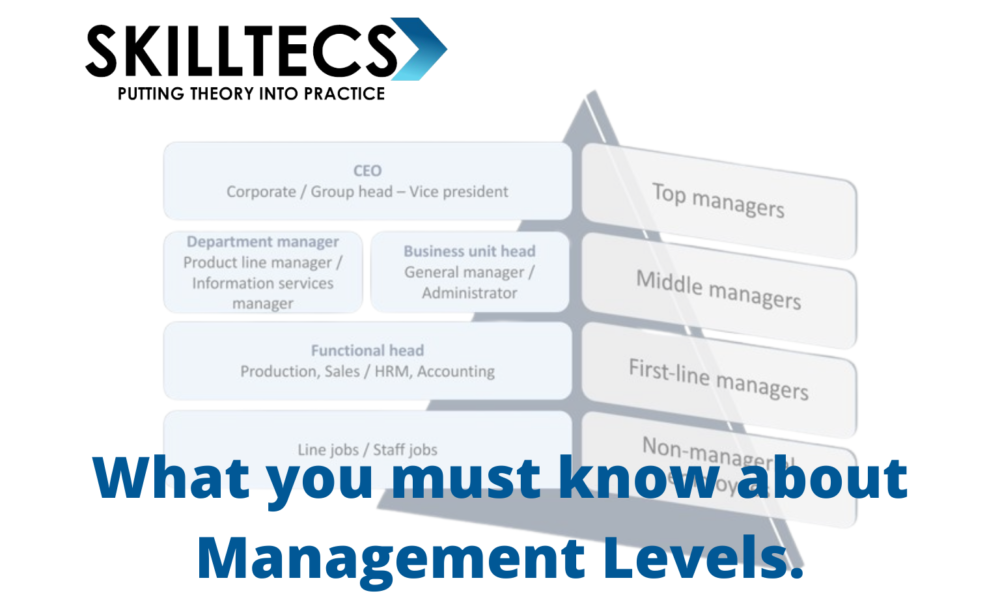Diagrams
What you must know about Management Levels.
The powers and responsibilities vary according to the administrative level occupied by the decision-maker or the position holder. Management, in general, is divided into three basic levels (top management, middle management, direct management, or first-line managers), each of them has responsibilities and powers commensurate with the tasks they perform.

Management is achieving the best results through the optimal use of material, financial and human resources.
Management has various functions that are integrated to achieve the goals of the organization, as it includes the functions of (planning, organizing, selection and induction of human resources, control, follow-up, and evaluation) as well as the functions of the organization that include (Production, marketing, procurement, inventory management, distribution. In addition to any other functions determined by the top management for the continuity of the organization and its survival in the business environment.
The powers and responsibilities vary according to the administrative level occupied by the decision-maker or the position holder. Management, in general, is divided into three basic levels (top management, middle management, direct management, or first-line managers), each of them has responsibilities and powers commensurate with the tasks they perform.
Top managers:
They are responsible for setting the strategy and main objectives of the organization, also defining the organization’s vision and mission to be a source of inspiration for all the organization’s employees when developing tactical, operational or action plans, as well as the organization’s values, which should be one of the criteria for hiring people and the main driver for making decisions or dealing with customers.
Middle managers:
Those managers represent the second level of the chain of command within organizations. This level is also called (tactical management), as they are responsible for transforming the strategic goals and plans set by the higher management into objectives and plans at the level of specific departments in the organization (such as production, marketing, and public relations plans). The work of this level is characterized by functional specialization based on the nature of the department’s work and its role as part of the organization. This level of managers has some financial and administrative powers that enable them to carry out tasks and ensure the effectiveness of work, such as hiring, setting standards for measuring and evaluating performance, as well as forming work teams, and appointing project managers.
First-line managers:
They are the direct managers or the leaders of the work teams who supervise the work details and implement the middle management’s plans through a specific action plan with an accurate schedule. The plans and decisions of this administrative level stem from the tactical plans of the middle management, where those plans are called operational or executive plans. First-line managers have the authority to monitor, direct, advise, draft performance reports and respond in the event of problems during the provision of the service to the customer.

Diagrams
List of Managerial Skill sets essential for business.

Management skills:

Conceptual skills:
The ability to see the organization as a whole and its interrelationships.
Human skills:
The ability to work with and through other people, and to work effectively as a group member.
Technical skills:
The experience and proficiency in the performance of specific tasks.
What are the manager’s roles?

There are ten main roles managers perform to maintain the effectiveness and efficiency of their organizations:

-

 Management Tools4 years ago
Management Tools4 years agoWhat is the Drill-Down technique?
-

 Management Tools4 years ago
Management Tools4 years agoAll you need to know about the Pareto principle and the 80/20 rule.
-

 Business3 years ago
Business3 years agoCommunication Rights & Responsibilities
-

 Business4 years ago
Business4 years agoHow to manage Unplanned and Sudden Tasks in 6 Steps like a Master?
-

 Business4 years ago
Business4 years agoWhat is Curriculum Development and how to implement it?
-

 Business4 years ago
Business4 years agoE.P.I.C. Model is the new trend in training delivery.
-

 Management Tools4 years ago
Management Tools4 years agoThe Appreciation Technique
-

 Business4 years ago
Business4 years agoWhat do you know about the 4Rs Marketing Mix?









Pingback: Conceptualizing Leadership in the 21st-century organizations. - SKILLTECS